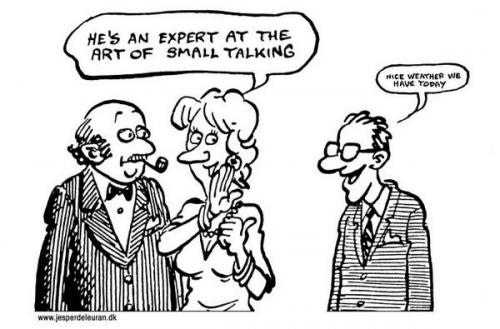Small talk is everywhere. Like, everywhere. And if often involves our first interaction with a person — either a brand-new person, or our first interaction with a friend/acquaintance when we reconnect with them. The thing is, it typically doesn’t mean anything. It’s all just babbling brook sounds about the weather or how was your flight or how was work (“OMG, you know, so slammed…”). What if you could make it meaningful, though?
You might be able to.
I started with this post from the TED blog about first impressions — good and important stuff, because, uh, first impressions are everything — and that led me to this post on the art of making meaningful small talk, which is in turn adapted from this book.
Hopefully you followed that bouncing ball. If you did, there are essentially three ways you can take idle chit-chat and make it somewhat meaningful:
- Ask for stories, not answers
- Break the mirror
- Leapfrog the expected response
Let’s break this down for a second.
Ask for stories, not answers: This is very logical. Our brain craves stories. That’s really what good marketing is all about. Your brain responds to stories and it contextualizes information in a charming, easier-to-access way. In a way, the ideas we have about everyone in our lives are rooted in the stories we assign to them. (Sorry for that deep thought.) But when we small talk, we don’t ask for stories; instead, we ask for answers. Here’s what I mean:
“How was your day?”
“Oh, good, but you know, so so busy…”
(That’s a question that leads to an answer.)
Now consider:
“Tell me three things you did today.”
“What the fuck? I was expecting you to ask me … well, OK, I mean I had this ridiculous meeting where no one knew the purpose or the point of it, and everyone was trying to justify why we were there, and…”
See: now you moved from answer (“it was good”) to story (“everyone is a complete and total moron…”) and that’s a bit more interesting and relevant.
Break the mirror: This is how most interactions go down:
“Weather’s great, eh?”
“Weather is great!”
Person A says something, and Person B agrees/reinforces. There’s no way to really move that forward; it’s just agreement. After a while, that’s boring as all hell. (This is why “opposites attract,” even though we all treat that concept as if it’s something really hard to understand; no one wants to spend their life with someone who keeps mirroring what they just said.)
Now try this:
“Weather’s great!”
“If we lived in San Diego, we’d shit on this weather.”
See the difference? Now a conversation can get rolling.
Leapfrog the expected response: In most small-talk situations, right, we say something and there’s an expected response, i.e. “How are you?” to —- > “Oh, I’m good.” It can be socially weird to completely break the expected response, but also fun. Here’s an excerpt on that:
Instead of :
Ron: How was your flight?
Carlos: My flight was good!Beverly: It’s hot today.
Gino: Yeah, it sure is hot.Riz: What’s up?
Keil: Hey, what’s up?Try:
Ron: How was your flight?
Carlos: I’d be more intrigued by an airline where your ticket price was based on your body weight and IQ.Beverly: It’s hot today.
Gino: In this dimension, yes.
This stuff can scare people — as humans, we believe the central connection we have is social, and that often involves going along and doing exactly what the situation seems to call for — but it can also shake things up, lead to more interesting conversations, and enter you into relationships, connections, and — dare I say it! — networking opportunities you never thought possible.
Shake it up, baby!

